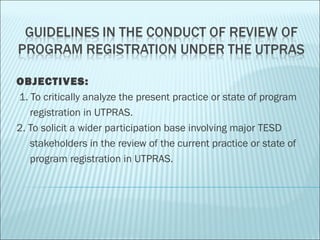
Utpras review guidelines presentation
- 1. OBJECTIVES: 1. To critically analyze the present practice or state of program registration in UTPRAS. 2. To solicit a wider participation base involving major TESD stakeholders in the review of the current practice or state of program registration in UTPRAS.
- 2. EXPECTED OUTPUT: A Strengths-Weaknesses-Opportunities-Threats (SWOT) Analysis Matrix of each of the 85 Provincial/District Offices and 17 Regional Offices.
- 3. Methodology to be used in the Review • Strengths-Weaknesses-Opportunities-Threats (SWOT) Analysis. Suggested par ticipants: • Technical Education and Skills Development Committee members; • President and/or officers of major TVET association(s) in the locality; • Representative(s) from any association of technology-based community training program providers in the locality, if any; and • Dominant industry association officer, if any, e.g. Officer(s) of the Chamber of Commerce and Industry in the locality.
- 4. Workshop Mechanics 1.Brief presentation on Program Registration in UTPRAS 2.Conduct of Orientation on the Review process (This presentation). 3.Conduct of actual SWOT Analysis workshop with the following reminders: • The review of Program Registration System shall not be confined to the guidelines, procedures, forms and documentation but also the “people” involved in implementing the system thus it should be a free-willing wide discussion. • The SWOT analysis workshop is meant to critically analyze program registration in its current state.
- 5. Workshop Mechanics • TESDA to facilitate the workshop. • The strengths and weaknesses shall refer to the internal factors that relate to the present situation of the Program Registration system. • The opportunities and threats are those external factors or those that relate to the external environment that will have an impact on the program registration system.
- 6. The following guide questions may be used in identifying the strengths, weaknesses, oppor tunities and threats of program registration in UTPRAS. Strengths What are the strong points of program registration in its current state? What are the advantages of the system to TESDA, if any? What do our external partners see as our strengths in program registration as it is currently being implemented? Weaknesses What are the disadvantages of program registration in its current state? What needs improvement in the system in its current state? What factors impede our progress in program registration? Opportunities What opportunities do you see in Program Registration What trends can you see in the system? Threats What threats does the system face externally What obstacles have to be overcome by the system?
- 7. Workshop Mechanics •The use of metacards for each item in the SWOT is recommended (one idea per metacard) coupled with brainstorming to enable each participant to elaborate on an issue/concern he/she raised to the question. • The long list of issues and concerns per area in the SWOT is then analyzed and synthesized (common issues and concerns are collapsed) to come up with a short list or a final itemization of the issues and concerns per area. The list can even be ranked in order of priority if it is too long or even ascribing points to items so that only the top 5 or so are entered into the final list.
- 8. Workshop Mechanics •The prioritized items are then entered into a SWOT Matrix as shown below:
- 9. Workshop Mechanics •After the Strengths, Weaknesses, opportunities and threats items have been entered into the matrix, the next activity will be to look at the cross-functionality of the table. In the intersecting cell e.g. Strengths-Opportunities, discuss and agree as a group what are the options you recommend for this interface. As a general rule come up with options to match Strengths with Opportunities and options to convert weaknesses to Strengths.
- 10. Workshop Mechanics The options are now entered into the table as shown below:
- 11. Workshop Mechanics •The hard copy and e-copy of the SWOT matrix output of each region and province/district including the directory of the participants shall be sent to TSDO for consolidation and analyses which shall become vital inputs to the Program Registration strategic plan.
- 12. Thank You!
